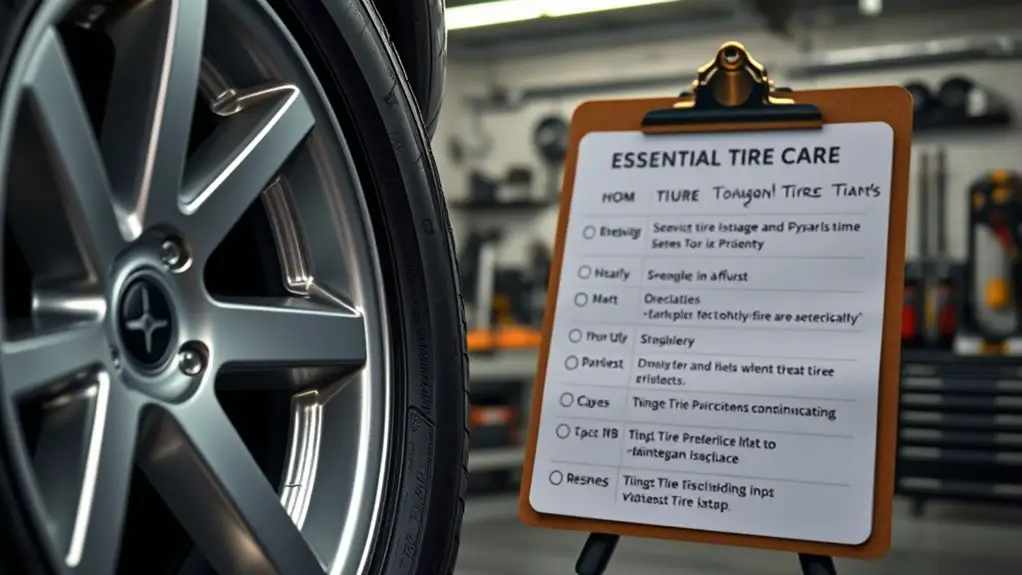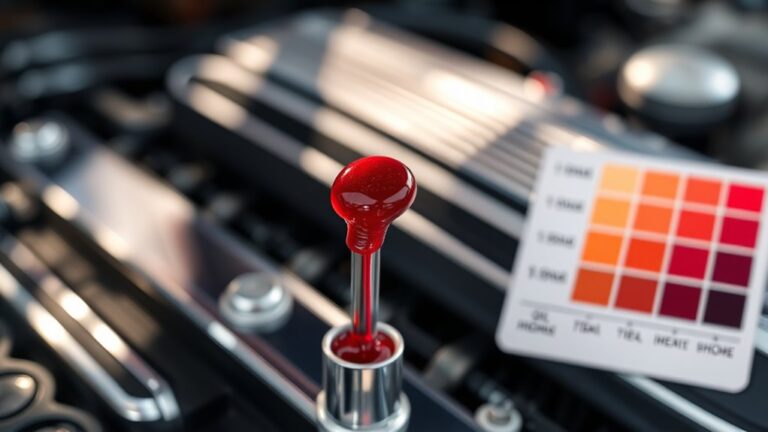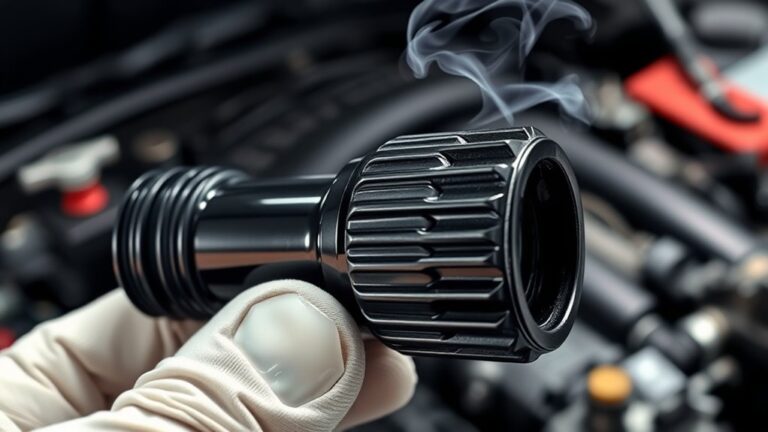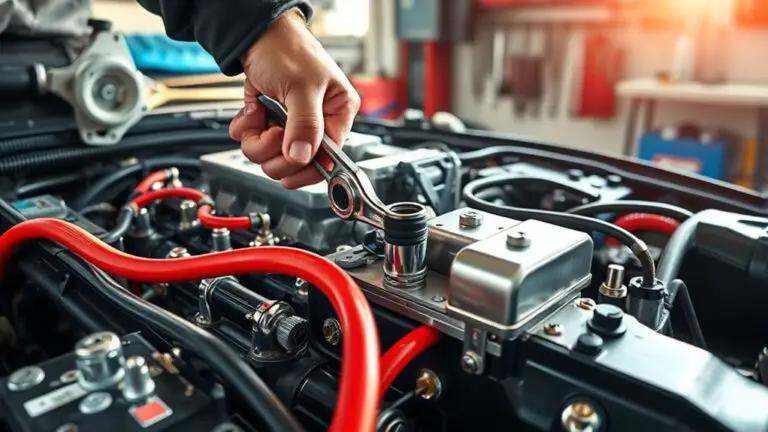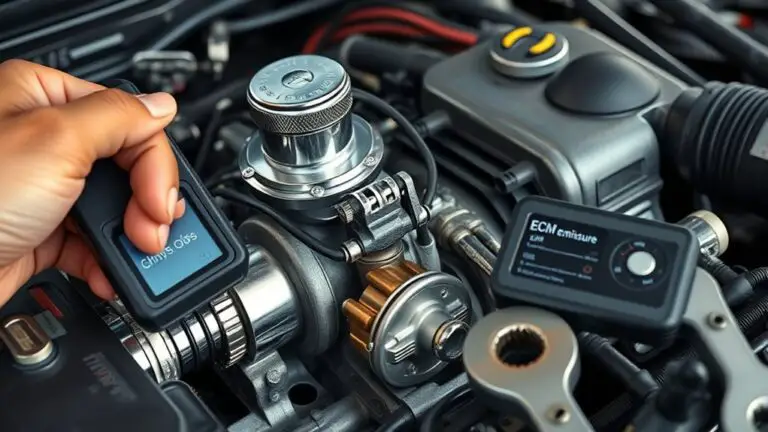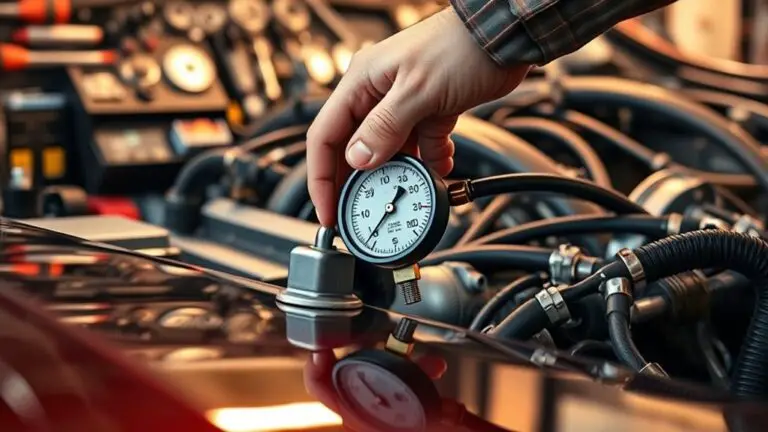Tire Maintenance Schedule to Avoid Sidewall Damage
A practical tire maintenance schedule helps you avoid sidewall damage and extend tire life. Regularly inspect both sides of each tire for cuts, bulges, or cracks, and note location and depth. Check cold tire pressure before driving with a reliable gauge, including the spare, and reseal valve caps after adjustments. Check tread depth and rotate tires as needed to promote even wear. If you notice bulges, deep cuts, or slow leaks, seek professional help—there’s more you can do beyond this.
Understanding Tire Sidewall Damage
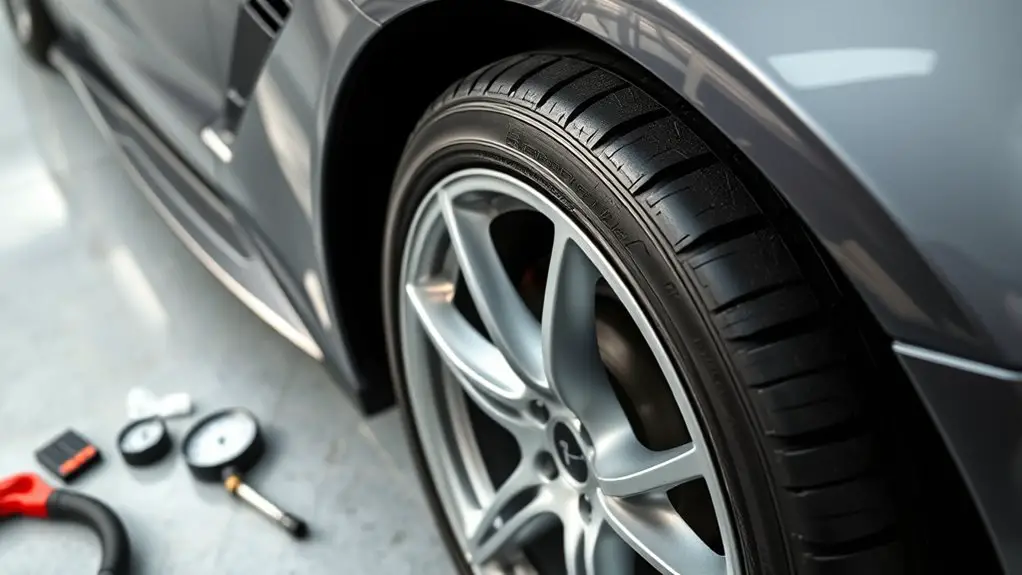
Tire sidewall damage can be subtle but serious, so inspect both sides of every tire each time you check air pressure. You’ve got to know what to look for and why it matters. Sidewall materials vary, but common vulnerabilities include cuts, bulges, and cracking from impact, underinflation, or aging. Early signs aren’t always dramatic, so treat any irregular texture, white lines, or discoloration as a red flag. Damage prevention starts with smooth handling, proper inflation, and aligned wheels, because pressure swings and potholes compound risk. When you spot something questionable, don’t delay: note the location, depth, and pattern, then compare with other tires for symmetry. Maintain a simple checklist: clean tires, monitor tread depth, and replace if the sidewall shows deep gouges or exposed cords. By staying proactive, you preserve flexibility, safety, and freedom on every road you ride.
Why a Maintenance Schedule Matters
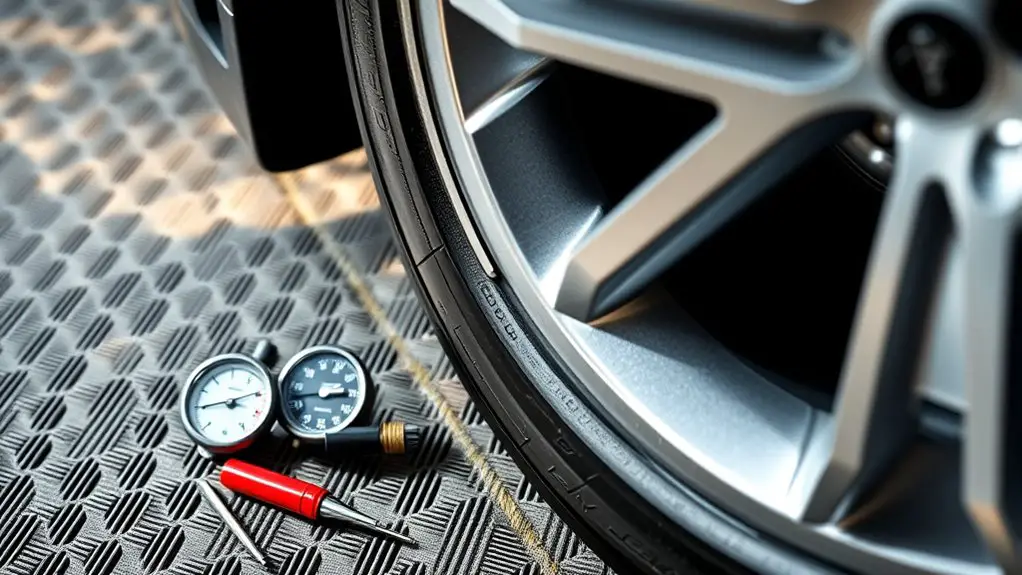
A maintenance schedule matters because it turns inspection into a routine, keeps wear predictable, and helps you catch issues before they become costly or unsafe. Think of it as a simple plan you can trust, not a checklist you dread. Regular timing reduces surprises and gives you clear signals when tires need attention. When you treat maintenance as a habit, tire longevity isn’t left to luck; it’s earned through deliberate, repeatable steps. You’ll know when to rotate, inflate to spec, and inspect for cuts or bulges without scrambling. The payoff isn’t just safer miles—it’s fewer roadside disruptions and steadier performance. The maintenance benefits extend beyond a single tire change: better fuel efficiency, balanced handling, and longer life for your entire set. Stay disciplined, document results, and adjust the schedule as your driving evolves. Your freedom to drive comes with responsibility, and a plan keeps both intact.
Checking Tread Depth Regularly
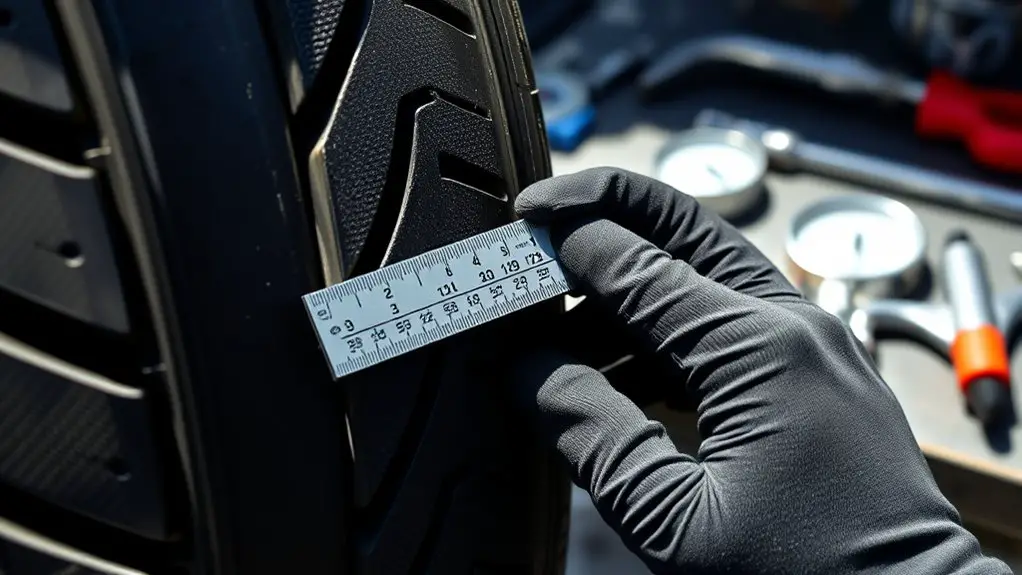
Checking tread depth regularly is essential for safe driving, and you should make it a quick, routine check rather than a guess. You’ll stay ahead of tread wear, protect grip, and avoid surprises on wet roads. Use a depth gauge or a simple coin test to verify you’re above the legal minimum and your own safety threshold. Be deliberate, not hasty, and log results so you notice trends.
- Inspect all four tires for even tread wear and use a depth gauge to confirm measurements.
- Compare readings to your vehicle’s recommended minimum and your personal safety margin, noting any uneven wear.
- Plan replacements or rotations if depth drops consistently on one axle, keeping performance consistent.
Consistency matters: frequent checks prevent silent declines, keep handling predictable, and reduce risk. When you’re precise with your numbers, you stay in control and ready for the road ahead.
Monitoring Tire Pressure Correctly
Maintaining proper tire pressure means checking and adjusting when needed to keep performance consistent and fuel efficiency reliable. You’ll monitor tire pressure regularly, since small changes affect handling, wear, and safety. Start with cold tires, ideally before driving, because heat can skew readings. Use a reliable pressure gauge and compare against the vehicle’s recommended range found on the door jamb or owner’s manual. Don’t guess; record the numbers and adjust in small increments. If a tire reads low, add air in short bursts and recheck until you reach the recommended level. If it’s high, release air gradually and recheck. Remember to check all four tires, plus the spare if you rotate seasons or roads frequently. Protect accuracy by resealing the valve stem cap and storing your gauge in a dry, clean place. Consistent tire pressure supports safe steering, balanced wear, and efficient fuel usage.
Protocol for Tire Rotation
Rotating your tires follows a simple pattern to guarantee even wear, balancing rotation patterns with your vehicle’s drivetrain. You’ll want to cover the basics of Rotation Pattern Basics and keep an eye on Pressure-Tire Balance so tires wear evenly and grip remains consistent. This first push sets the stage for a practical, precise rotation routine you can follow.
Rotation Pattern Basics
When you set up tire rotations, follow a simple, repeatable pattern to guarantee even wear and extend tire life. This rotation pattern basics guide keeps things straightforward, so you stay in control of tire wear without overthinking it.
1) Choose a standard front-to-back pattern for non-directional tires, swapping front and rear on the same side.
2) For directional tires or staggered setups, switch sides when safe and follow manufacturer recommendations to preserve rotation integrity.
3) Mark tires or keep a log to confirm you’re rotating at regular intervals, ensuring even tread depth and avoiding uneven tire wear.
This approach balances practicality with freedom, offering clear steps that protect sidewalls while supporting reliable handling and longevity. rotation patterns, tire wear
Pressure-Tire Balance
Even with a steady rotation pattern, pressure-tire balance matters as much as tread depth, so check and adjust tire pressures to ride, steer, and wear evenly. In practice, you aim for a consistent contact patch across all wheels, because uneven pressures transfer load unevenly and cause sidewall stress. Start with the vehicle’s recommended tire inflation from the door jamb or owner manual, then verify with a accurate gauge. Don’t overinflate or underinflate; both distort handling and shorten tire life. When rotating, reassess balance and reset pressures to maintain a balanced load among tires. If you feel vibration or pull, inspect for valve, bead seating, or wheel damage instead of assuming balance alone. Maintain tire inflation discipline and prioritize a balanced load for reliable, predictable performance.
Inspecting for Sidewall Cracks and Bulges
You should inspect sidewalls for visible cracks and any bulges, as early signs can help prevent flats. Look for small cracks, changes in texture, or unusual bumps that might indicate internal damage. Remember that pressure and temperature affect sidewall condition, so check tire PSI and heat buildup to interpret these signs accurately.
Visual Sidewall Cracks
Visual sidewall cracks are a warning sign that tires may be nearing the end of their safe life. You’ll want to spot them early and act decisively, using direct checks and clear decisions. Here’s how to stay ahead:
1) Look for weathering lines, splits, or shallow fissures along the sidewall, especially near the rim and tread edge. These are visual indicators that the tire’s structure is stressed and could fail under load.
2) Document any cracks with a quick inspection note, then compare with mileage and age. If cracking worsens or extends around the sidewall, preventive measures include reducing speed, avoiding potholes, and scheduling service.
3) Maintain proper inflation, rotate tires per schedule, and replace compromised tires promptly to preserve safety and freedom on the road.
Detecting Bulges Early
Bulges in the sidewall are a clear warning sign that a tire’s internal structure is compromised, so it’s worth inspecting carefully and acting fast. You’ll want to spot bulge types early and prevent a roadside failure. Look for soft spots, uneven tread, and changes that appear overnight. If you notice a bulge, don’t drive on it; replace or repair per guidance. Early detection saves you from more expensive damage and a dangerous blowout. Use a calm, methodical check: push on the tire, compare sides, and review tread wear patterns.
| Bulge type | Action |
|---|---|
| Surface blister | Replace immediately |
| Lateral lump | Inspect, consider instant replacement |
Pressure and Temperature Effects
Pressure and temperature changes can reveal sidewall cracks and bulges that aren’t obvious at a glance. You’ll notice how pressure fluctuations and temperature extremes stress tires, widening gaps and stressing the sidewalls during routine checks. To keep findings precise, inspect after a cooldown and compare against your vehicle’s standard load. Stay methodical and avoid guessing, because small cues can signal larger issues.
- Check for slow, uniform bead leakage and subtle edge distortions after hot-road exposure.
- Look for linear cracks or bulges that persist as tires cool and lose pressure.
- Note any uneven wear patterns or sudden changes following temperature extremes, then document and act.
Stay vigilant, and address anomalies promptly to preserve performance and freedom on the road.
Spotting Slow Leaks and Punctures
Spotting slow leaks and punctures starts with a careful inspection of your tires’ tread and sidewalls for signs of air loss, such as a gradual drop in pressure over days or weeks. You’ll tighten your vigilance by checking for uneven wear, embedded objects, and tread wear indicators that hint at slow leak detection. Look for shiny rims, bead seating changes, or a whiff of sealant that betrays small punctures. Use a soapy solution on the tire and valve stem to reveal bubbles that signal air escaping. Don’t overlook the valve core; a loose core can mimic a puncture. If you spot a leak, isolate it with a rapid pressure check over a 24-hour window to confirm persistence. For any confirmed leak, pursue puncture repair only if damage is within repairable zones and your tire remains safe to repair. Maintain records and schedule follow-ups to prevent sidewall failures.
Alignments and Balancing Essentials
Alignments and balancing keep your tires wear even and steering true. You’ll want to know the basics of wheel alignment, why balancing matters, and how to spot signs of imbalance or other issues. Stay aware of practical checks you can perform and when to seek professional alignment and balancing service.
Wheel Alignment Basics
Wheel alignment basics are essential for safe handling and even tire wear, so you’ll want to understand how camber, toe, and caster affect steering and tire contact. You’ll learn practical checks you can perform and when to call a pro. Track alignment references align with your car’s geometry, not guesswork, so your drive stays precise and predictable.
- wheel alignment techniques you can apply, like verifying camber and toe with simple tools and understanding their impact on tire wear.
- alignment tools you’ll rely on to measure angles, compare to manufacturer specs, and confirm adjustments.
- practical timing and steps to plan adjustments without guesswork, focusing on safety, handling, and longevity of tires and suspension.
Balancing Importance Keys
After covering wheel alignment basics, it’s natural to dial in another comfort and safety factor: balancing. You’ll see it as a practical guardrail against vibration, uneven wear, and pulled steering. Balancing techniques focus on restoring rotational symmetry so tires run true at any speed. The core move is matching wheel and tire mass with precision, using lightweight tire weights placed where the imbalance shows up most. You’ll want to account for dynamic and static imbalances, and recheck after mounting or tire changes. Keep measurements clean: avoid guesswork, aim for gradual corrections, and verify results on a road test. When done right, alignment and balancing work together to protect sidewalls, improve ride feel, and extend tire life.
Signs of Imbalance/Issues
Uneven wear, vibration, and pulling are classic signs something’s off with balance or alignment. You’ll notice how tire wear and visual inspections reveal alignment issues, or balancing problems, early on. Stay alert to these indicators and keep maintenance reminders in your calendar.
- Look for vibration signs and steering instability during highway runs or pothole hits, plus noise levels that aren’t usual.
- Check for uneven tread patterns and handling difficulties that feel off, especially when braking or cornering.
- Perform quick visual inspections for tire wear consistency, steering response, and any subtle resonance; address issues before they escalate.
Seasonal and Road-Condition Considerations
Seasonal changes and road conditions can dramatically affect tire wear and grip, so adjust your maintenance routine accordingly. You’ll loosen up or tighten up checks based on the forecast and surface reality you’ll encounter. Weather impacts show up as tire pressure shifts, tread feel, and braking response, so verify PSI when temps swing and after long rides. Track terrain variations—potholes, frost heave, gravel, or dirt roads—before you roll, since these stress the sidewalls more than smooth pavement. Rotate more frequently if seasons bring uneven wear, and balance after any rough corridor you traverse. Inspect tread depth and sidewall integrity after major weather events, like heavy rain, freeze-thaw cycles, or heat spikes. Use proper tires for expected conditions, and keep a spare, a pump, and a gauge in reach. Maintain alignment as needed to preserve straight tracking, reduce scrub, and extend tire life while enjoying the freedom to explore.
When to Seek Professional Help
When your tire maintenance shows signs you can’t safely address at home, it’s time to seek professional help. You’ll benefit from precise assessments that prevent costly failures and keep you free on the road. Look to trusted practices from tire specialists who prioritize safety and performance.
1) Recognize red flags: sidewall bulges, deep cuts, uneven tread wear, or leakage—these warrant professional diagnostics before anything else.
2) Schedule promptly: don’t delay when unusual vibrations, steering pull, or abnormal tire noise appears; timely evaluation minimizes downtime and risk.
3) Choose specialists: confirm credentials, warranty support, and access to accurate load, pressure, and alignment data. Rely on their measurements and documented recommendations.
Professional diagnostics deliver actionable conclusions, not guesswork. You’ll leave with clear next steps, whether repair, rotation, or replacement, and a maintenance plan that supports your freedom to drive confidently.
Frequently Asked Questions
Can Tire Sidewall Damage Occur Without Visible Bulges or Cuts?
Yes, sidewall damage can occur without obvious bulges or cuts. You might notice subtle deformations, cracking, or soft spots that compromise sidewall integrity. Regular checks of tire pressure help you spot gradual losses and prevent unseen damage. Keep your tires inflated to the recommended level, inspect for unusual wear, and address vibrations or handling changes promptly. Protect your sidewall integrity by treating tires gently, avoiding overloading, and replacing damaged tires before they fail.
How Often Should I Replace Tires With Minor Sidewall Cracks?
You should replace tires with minor sidewall cracks when their crack severity assessment indicates structural compromise or near-tolerance limits, typically not immediately, but within a practical timeframe. Consider tire lifespan factors like crack depth, location, exposure, and age. If cracks worsen or you notice air loss, replace sooner. Regular inspections help. You must balance safety with freedom to drive. Prioritize road-ready tires, and don’t delay if integrity seems doubtful.
Do Tire Brands Differ in Recommended Sidewall Maintenance?
Yes, tire brands differ in recommendations, but general sidewall care applies to all. You should follow your specific brand’s guidelines for pressure, load, and inspection intervals, then adapt with regular checks. Compare tire brand comparisons for inflation targets and wear indicators, not just tread. You’ll stay safer by avoiding over- or underinflation, inspecting for cracks, cuts, and bulges, and rotating tires on schedule. Freedom comes from consistent maintenance and informed brand-specific tweaks.
Can Uneven Tire Wear Signal Alignment Issues Needing Repair?
Uneven tire wear can signal alignment issues that need repair. About 60% of vehicle misalignment cases show abnormal tread wear within the first 3,000 miles, so you should inspect early. If you notice feathered, cupped, or edge wear, get a professional alignment and tire rotation. Regularly check tire alignment and tread wear; correcting alignment preserves safe handling and extends tire life, helping you maintain control and freedom on the road.
Are Temporary Fixes Like Sealants Safe for Sidewall Damage?
Temporary fixes like sealants are not safe for sidewall damage; they’re not a cure and can mask leaks or worsen failure. Instead, seek professional assessment and repair. For sealant effectiveness, don’t rely on it long term—use it only as a temporary stopgap. If you want freedom in your ride, prioritize a proper tire repair or replacement, plus addressing root causes like punctures, cuts, or bulges, and maintain regular inspections.

